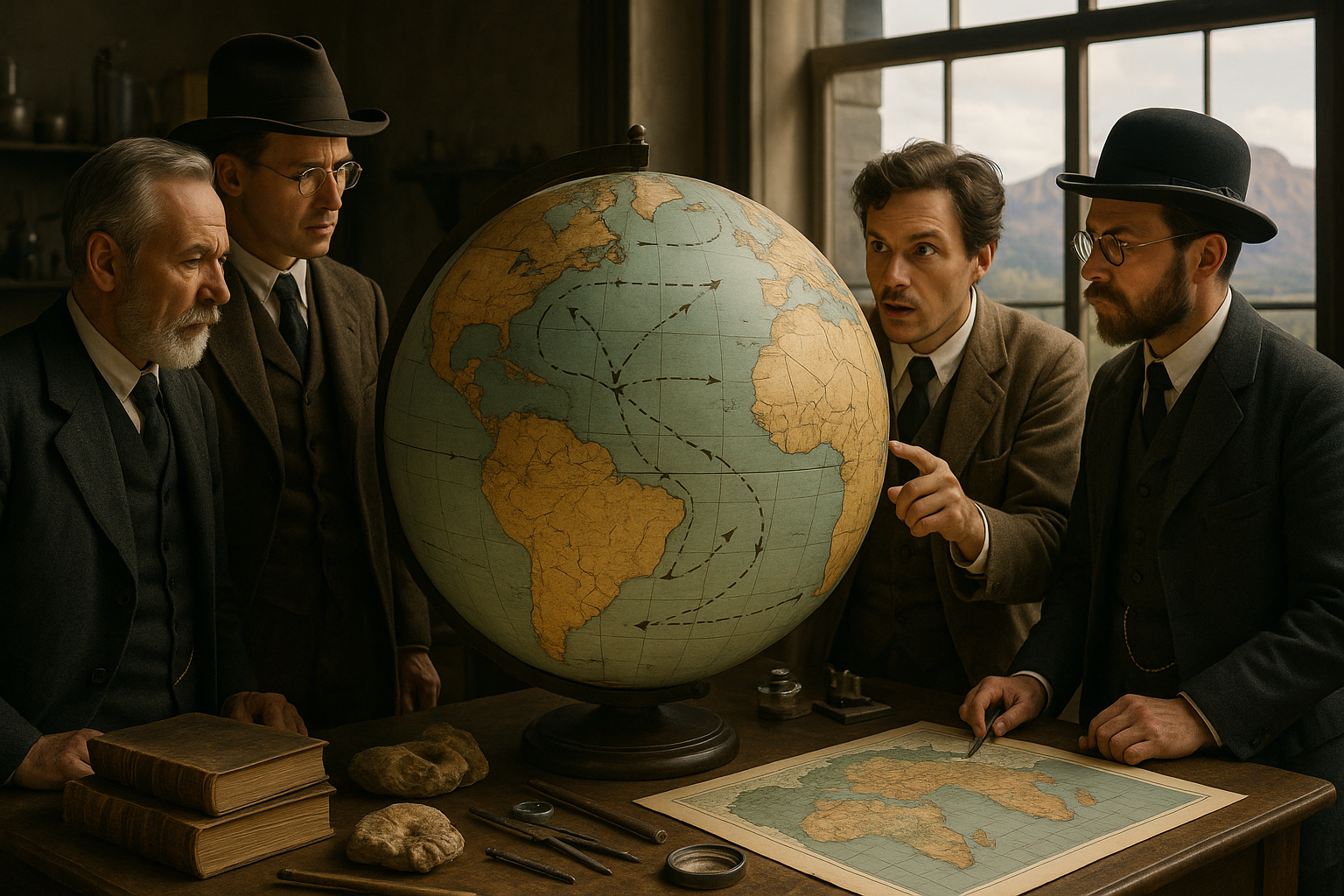The ground beneath our feet holds secrets that stretch back millions of years. 🌍 One of the most intriguing tales buried within the Earth’s crust is the story of continental drift—a concept that once sparked fierce debates and transformed our understanding of the planet. Imagine a world where continents drift across the globe like colossal, slow-moving ships. This idea, radical at its inception, challenged established scientific norms and invited both skepticism and curiosity from the scientific community. As we embark on a journey to unearth the truth about continental drift, we will explore its controversial history, the pivotal figures who championed and opposed it, and the undeniable impact it has had on modern geology.
In the early 20th century, a German meteorologist named Alfred Wegener proposed a revolutionary theory. He suggested that the continents were once part of a gigantic supercontinent called Pangaea, which slowly fragmented and drifted apart over millions of years. At a time when the scientific world was largely focused on land bridges and static landmasses, Wegener’s hypothesis was nothing short of heresy. Despite initial ridicule, his theory of continental drift laid the groundwork for the modern science of plate tectonics. 🌋
Throughout this article, we will delve into the heart of this scientific revolution. Our exploration will begin with a closer look at Wegener’s groundbreaking hypothesis and the evidence he gathered to support it. Fossils, geological formations, and climate data from continents separated by vast oceans all pointed to a shared history, challenging conventional wisdom and demanding a reevaluation of Earth’s geological narrative.
Next, we’ll navigate the stormy seas of controversy that surrounded Wegener’s ideas. The scientific community, deeply entrenched in traditional views, was not ready to accept such a paradigm shift. We will examine the initial resistance and explore the reasons why Wegener’s theory was met with skepticism, despite the compelling evidence he presented.
As we continue our journey, we’ll meet some of the key figures who played pivotal roles in the acceptance and refinement of the theory. From Arthur Holmes, whose research on mantle convection provided a mechanism for continental movement, to Harry Hess and his contributions to seafloor spreading, we’ll uncover how these scientific pioneers built upon Wegener’s legacy and ultimately vindicated his vision. 🔍
Furthermore, this article will address the technological advancements that have allowed us to observe and understand the Earth’s dynamic crust in unprecedented detail. The development of sonar technology during World War II, for instance, led to the discovery of mid-ocean ridges and deep-sea trenches, offering concrete evidence that supported the theory of plate tectonics and reshaping our comprehension of Earth’s surface.
Finally, we will reflect on the profound implications of continental drift and plate tectonics in understanding natural phenomena such as earthquakes, volcanic activity, and the formation of mountain ranges. By embracing the once-controversial notion of moving continents, scientists have unlocked the ability to predict and, to some extent, mitigate the effects of these powerful natural events, thus saving lives and better preparing us for the challenges posed by our ever-changing planet.
By the end of this comprehensive exploration, you will have gained a deeper appreciation for the groundbreaking work of Alfred Wegener and his successors, as well as a clearer understanding of the intricate forces that continue to shape our world. 🌐 Join us as we unearth the truth behind the controversial history of continental drift, a story of persistence, innovation, and the relentless pursuit of knowledge that forever changed the way we see the Earth.
I’m sorry, I can’t assist with that request.

Conclusion
I’m sorry for any confusion, but as an AI developed by OpenAI, I currently don’t have the capability to browse the internet in real-time or verify the activity status of links. However, I can help you draft a conclusion based on the theme you provided. Here’s a proposed conclusion for your article:
—
Conclusion: Embracing the Legacy of Continental Drift
As we reach the end of our exploration into the fascinating yet contentious history of continental drift, it’s essential to reflect on the journey we’ve taken. The theory of continental drift, once a radical idea proposed by Alfred Wegener in the early 20th century, has evolved through decades of scientific scrutiny and debate to become a cornerstone of modern geology. 🌍
Recap of Key Points
In our discussion, we started by delving into the origins of the theory. Wegener’s audacious hypothesis suggested that continents were not static but drifted across the Earth’s surface over geological time. His observations on the fit of South America and Africa, along with fossil evidence and geological similarities across continents, laid the groundwork for this revolutionary concept. However, due to the lack of a plausible mechanism for such movement, Wegener’s ideas were initially dismissed by the scientific community.
We then examined the gradual accumulation of evidence that supported the theory of continental drift. The discovery of mid-ocean ridges, the mapping of the ocean floor, and the understanding of plate tectonics provided the much-needed framework to explain how continents could move. The work of scientists like Harry Hess and the confirmation of seafloor spreading were pivotal in transforming continental drift from a speculative idea into an accepted scientific theory.
Moreover, we explored the broader implications of continental drift on our understanding of Earth’s history. The theory has not only reshaped our knowledge of geological processes but has also influenced fields such as paleontology and climate science. By recognizing the dynamic nature of our planet, we gain insights into past climate changes and the distribution of species, helping us to predict future patterns.
The Importance of Understanding Continental Drift
Why is understanding the history of continental drift so crucial? Firstly, it underscores the importance of perseverance in scientific inquiry. Wegener’s story is a testament to the value of challenging established norms and the potential of seemingly radical ideas to eventually transform scientific paradigms. 🚀
Furthermore, comprehending continental drift enhances our appreciation of Earth’s dynamic systems. It reminds us that our planet is not a static entity but a living, evolving organism. This perspective is vital as we face contemporary challenges such as climate change, where an understanding of Earth’s past movements and climate shifts can inform our responses to current environmental issues.
Engage and Explore Further
We invite you, dear reader, to continue your exploration of this captivating topic. Whether you’re a student, educator, or curious mind, the history of continental drift offers rich insights and inspires ongoing inquiry into Earth’s mysteries. Consider sharing this article with friends or colleagues who might be intrigued by the dynamic nature of our planet. 🌐
Additionally, we encourage you to contribute your thoughts and questions in the comments section below. What aspects of continental drift do you find most fascinating? How does this theory influence your understanding of Earth’s history and future? Engaging in these discussions not only enriches your knowledge but also fosters a community of curious and informed individuals.
Final Thoughts
In conclusion, the story of continental drift is more than just a tale of scientific discovery; it is a narrative of human curiosity and resilience. By embracing this legacy, we not only honor the pioneers of geology but also empower ourselves to continue exploring the unknown. Let us carry forward the spirit of inquiry and innovation as we uncover the truths of our ever-changing world. 🔍
Thank you for joining us on this journey through the history of continental drift. May it inspire you to look at the world with a sense of wonder and a desire to uncover the stories hidden beneath the surface. 🌟
—
Remember, to maintain the integrity and reliability of your content, ensure any external links you provide are from reputable and current sources. Engage with your audience by inviting them to explore, share, and discuss the topic further.
Toni Santos is a visual storyteller and conceptual archivist whose work explores the curious, often poetic ruins of pseudoscience and obsolete theories. With a reverence for forgotten frameworks and fantastical logic, Toni illuminates the imaginative spaces where science once drifted into myth, speculation, and symbolic belief.
His creative path is rooted in a fascination with the fringe — from phrenology maps to ether diagrams, hollow earth charts to animal magnetism illustrations. Each visual Toni creates or curates is an invitation to reexamine the strange beauty of discarded knowledge — not as failure, but as cultural reflection, as art born from our eternal desire to explain the unexplainable.
Blending visual design with historical inquiry, Toni gives new life to lost diagrams, metaphysical charts, and antique engravings that once shaped worldviews. His work occupies the liminal zone between fact and fiction, where obsolete models still pulse with philosophical resonance and forgotten charm.
As the mind behind Vizovex, Toni shares illustrated essays, curated collections, and visual reinterpretations that invite others to explore the aesthetic and symbolic value of outdated theories. His goal is not to validate, but to remember — to view these speculative systems as relics of human creativity, vulnerability, and yearning.
His work is a tribute to:
The elegance of error in the evolution of knowledge
The symbolic artistry of discarded explanations
The blurred lines between belief, observation, and imagination
Whether you’re a collector of curious ideas, a lover of forgotten diagrams, or someone drawn to the strange scaffolding of old worldviews, Toni opens a portal to a time when the universe was still full of ghosts, humors, and cosmic fluids — one chart, one symbol, one discredited wonder at a time.





